Microstrip Sensor Based on Ring Resonator Coupled with Double Square Split Ring Resonator for Solid Material Permittivity Characterization
Abstract
:1. Introduction
2. Sensor Design: The Materials
2.1. Design of Square Resonator with Microstrip Feed Line
2.2. Double Square Split Ring Resonator Sensing Principle
2.3. Simulation of Square Resonator Coupled Double Square Split Resonator
3. The Resonant Frequency Analysis
4. Result and Discussion
5. Conclusions
Author Contributions
Funding
Institutional Review Board Statement
Data Availability Statement
Conflicts of Interest
References
- Paul, R.B.; Engin, A.E.; Aguirre, J. Dielectric and Underfill Characterization Using Cavity Resonators for Millimeter-Wave Applications. IEEE Lett. Electromagn. Compat. Pract. Appl. 2020, 2, 76–80. [Google Scholar] [CrossRef]
- Alam, S.; Zakaria, Z.; Surjati, I.; Shairi, N.A.; Alaydrus, M.; Firmansyah, T. Dual-Band Independent Permittivity Sensor Using Single-Port with a Pair of U-Shaped Structures for Solid Material Detection. IEEE Sens. J. 2022, 22, 16111–16119. [Google Scholar] [CrossRef]
- Wee, F.H.; Soh, P.J.; Suhaizal, A.H.M.; Nornikman, H.; Ezanuddin, A.A.M. Free space measurement technique on dielectric properties of agricultural residues at microwave frequencies. In Proceedings of the SBMO/IEEE MTT-S International Conference on Microwave and Optoelectronics (IMOC), Belem, Brazil, 3–6 November 2009; pp. 183–187. [Google Scholar] [CrossRef]
- Bor, J.; Lafond, O.; Merlet, H.; Le Bars, P.; Himdi, M. Technological process to control the foam dielectric constant application to microwave components and antennas. IEEE Trans. Compon. Packag. Manuf. Technol. 2014, 4, 938–942. [Google Scholar] [CrossRef] [Green Version]
- Okada, K.; Kurimoto, K.; Suzuki, M. Anomalous TDDB Statistics of Gate Dielectrics Caused by Charging-Induced Dynamic Stress Relaxation under Constant-Voltage Stress. IEEE Trans. Electron. Devices 2016, 63, 2268–2274. [Google Scholar] [CrossRef]
- Monkevich, J.M.; Le Sage, G.P. Design and Fabrication of a Custom-Dielectric Fresnel Multi-Zone Plate Lens Antenna Using Additive Manufacturing Techniques. IEEE Access 2019, 7, 61452–61460. [Google Scholar] [CrossRef]
- Ansari, M.A.H.; Jha, A.K.; Akhtar, M.J. Design and Application of the CSRR-Based Planar Sensor for Noninvasive Measurement of Complex Permittivity. IEEE Sens. J. 2015, 15, 7181–7189. [Google Scholar] [CrossRef]
- Jilnai, M.T.; Wen, W.P.; Cheong, L.Y.; Rehman, M.Z.U. A microwave ring-resonator sensor for non-invasive assessment of meat aging. Sensors 2016, 16, 52. [Google Scholar] [CrossRef] [Green Version]
- Valencia-Balvín, C.; Pérez-Walton, S.; Osorio-Guillén, J.M. First principles calculations of the electronic and dielectric properties of λ-Ta2O5. TecnoLógicas 2018, 21, 43–52. [Google Scholar] [CrossRef] [Green Version]
- Saeed, K.; Pollard, R.D.; Hunter, I.C. Substrate integrated waveguide cavity resonators for complex permittivity characterization of materials. IEEE Trans. Microw. Theory Tech. 2008, 56, 2340–2347. [Google Scholar] [CrossRef]
- Velez, P.; Munoz-Enano, J.; Ebrahimi, A.; Herrojo, C.; Paredes, F.; Scott, J.; Ghorbani, K.; Martin, F. Single-frequency amplitude-modulation sensor for dielectric characterization of solids and microfluidics. IEEE Sens. J. 2021, 21, 12189–12201. [Google Scholar] [CrossRef]
- Abbood, A.; Mocanu, I.A.; Codreanu, N.; Pantazica, M. Modified Split Ring Resonators Sensor for Accurate Complex Permittivity Measurements of solid dielectrics. Sensors 2020, 20, 6855. [Google Scholar]
- Wu, W.J.; Zhao, W.S.; Wang, D.W.; Yuan, B.; Wang, G. Ultrahigh-Sensitivity Microwave Microfluidic Sensors Based on Modified Complementary Electric-LC and Split-Ring Resonator Structures. IEEE Sens. J. 2021, 21, 18756–18763. [Google Scholar] [CrossRef]
- Velez, P.; Su, L.; Grenier, K.; Mata-Contreras, J.; Dubuc, D.; Martin, F. Microwave Microfluidic Sensor Based on a Microstrip Splitter/Combiner Configuration and Split Ring Resonators (SRRs) for Dielectric Characterization of Liquids. IEEE Sens. J. 2017, 17, 6589–6598. [Google Scholar] [CrossRef] [Green Version]
- Bogner, A.; Steiner, C.; Walter, S.; Kita, J.; Hagen, G.; Moos, R. Planar microstrip ring resonators for microwave-based gas sensing: Design aspects and initial transducers for humidity and ammonia sensing. Sensors 2017, 17, 2422. [Google Scholar] [CrossRef]
- Al-Gburi, J.A.; Zakaria, Z.; Rahman, N.A.; Alam, S.; Said, M.A.M. A Compact and Low-Profile Curve-Feed Com-plementary Split-Ring Resonator Microwave Sensor for Solid Material Detection. Micromachines 2023, 14, 384. [Google Scholar] [CrossRef]
- Sensitivity, H.; Tolerance, L.F. Rapid Design Optimization and Calibration of Microwave Sensors Based on Equivalent Complementary Resonators for High Sensitivity and Low Fabrication Tolerance. Sensors 2023, 23, 1044. [Google Scholar]
- Oliveira, J.G.D.; Pinto, E.N.M.G.; Neto, V.P.S.; D’assunção, A.G. CSRR-based microwave sensor for dielectric mate-rials characterization applied to soil water content determination. Sensors 2020, 20, 255. [Google Scholar] [CrossRef] [Green Version]
- Aiswarya, S.; Menon, S.K.; Donelli, M.; Meenu, L. Development of a microwave sensor for solid and liquid substances based on closed loop resonator. Sensors 2021, 21, 8506. [Google Scholar] [CrossRef]
- Armghan, A.; Alanazi, T.M.; Altaf, A.; Haq, T. Characterization of Dielectric Substrates Using Dual Band Microwave Sensor. IEEE Access 2021, 9, 62779–62787. [Google Scholar] [CrossRef]
- Xiao, H.; Yan, S.; Guo, C.; Chen, J. Microwave/millimeter wave sensors A Dual-Scale CSRRs-Based Sensor for Dielectric Characterization of Solid Materials. IEEE Sens. Lett. 2022, 6, 1–4. [Google Scholar] [CrossRef]
- Nogueira, J.K.A.; Oliveira, J.G.D.; Paiva, S.B.; Neto, V.P.S.; D’assunção, A.G. A Compact CSRR-Based Sensor for Characterization of the Complex Permittivity of Dielectric Materials. Electronics 2022, 11, 1787. [Google Scholar] [CrossRef]
- Wang, C.; Ali, L.; Meng, F.-Y.; Adhikari, K.K.; Zhou, Z.L.; Wei, Y.C.; Zou, D.Q.; Yu, H. High-Accuracy Complex Permittivity Characterization of Solid Materials Using Parallel Interdigital Capacitor- Based Planar Microwave Sensor. IEEE Sens. J. 2021, 21, 6083–6093. [Google Scholar] [CrossRef]
- Sorocki, J.; Rydosz, A.; Staszek, K. Wideband microwave multiport-based system for low gas concentration sensing and its application for acetone detection. Sens. Actuators B Chem. 2020, 323, 128710. [Google Scholar] [CrossRef]
- Guarin, G.; Hofmann, M.; Nehring, J.; Weigel, R.; Fischer, G.; Kissinger, D. Miniature Microwave Biosensors: Noninvasive Applications. IEEE Microw. Mag. 2015, 16, 71–86. [Google Scholar] [CrossRef]
- Cheong, P.; Wu, K. Full-Range CSRR-Based Angular Displacement Sensing With Multiport Interferometric Platform. IEEE Trans. Microw. Theory Tech. 2021, 69, 4813–4821. [Google Scholar] [CrossRef]
- Julrat, S.; Chongcheawchamnan, M.; Robertson, I.D. Differential six-port reflectometer for determining dry rubber content of latex. IET Microw. Antennas Propag. 2015, 9, 847–851. [Google Scholar] [CrossRef]
- Carnerero-Cano, J.; Galindo-Romera, G.; Martinez-Martinez, J.J.; Herraiz-Martinez, F.J. A Contactless Dielectric Constant Sensing System Based on a Split-Ring Resonator-Loaded Monopole. IEEE Sens. J. 2018, 18, 4491–4502. [Google Scholar] [CrossRef]
- Chuma, E.L.; Iano, Y.; Fontgalland, G.; Roger, L.L.B. Microwave sensor for liquid dielectric characterization based on metamaterial complementary split ring resonator. IEEE Sens. J. 2018, 18, 9978–9983. [Google Scholar] [CrossRef]
- Liu, X.; Zhang, D.; Yu, S.; Wang, C.; Yang, X.; Wang, Y. A Dual-Band Resonator Sensor for Low Permittivity Characteri-zation. IEEE Trans. Instrum. Meas. 2022, 71, 1–11. [Google Scholar] [CrossRef]
- Gan, H.-Y.; Zhao, W.-S.; He, L.; Yu, Y.; Xu, K.; Wen, F.; Dong, L.; Wang, G. A CSRR-Loaded Planar Sensor for Simultaneously Measuring Permittivity and Permeability. IEEE Microw. Wirel. Compon. Lett. 2020, 30, 219–221. [Google Scholar] [CrossRef]
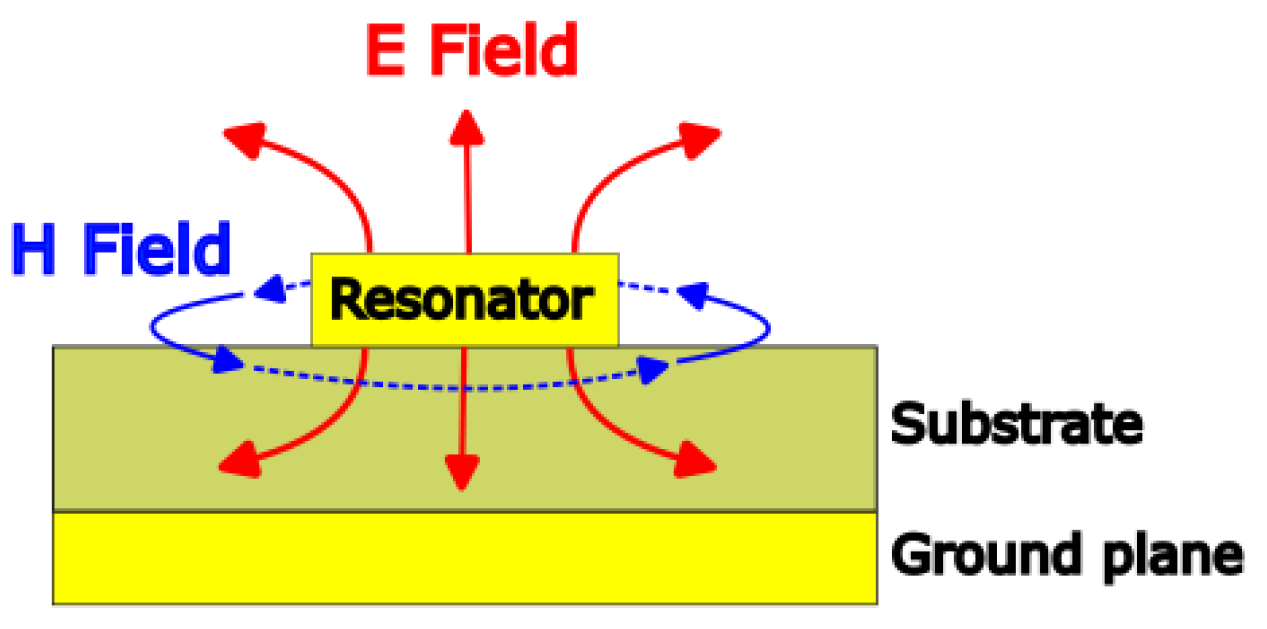

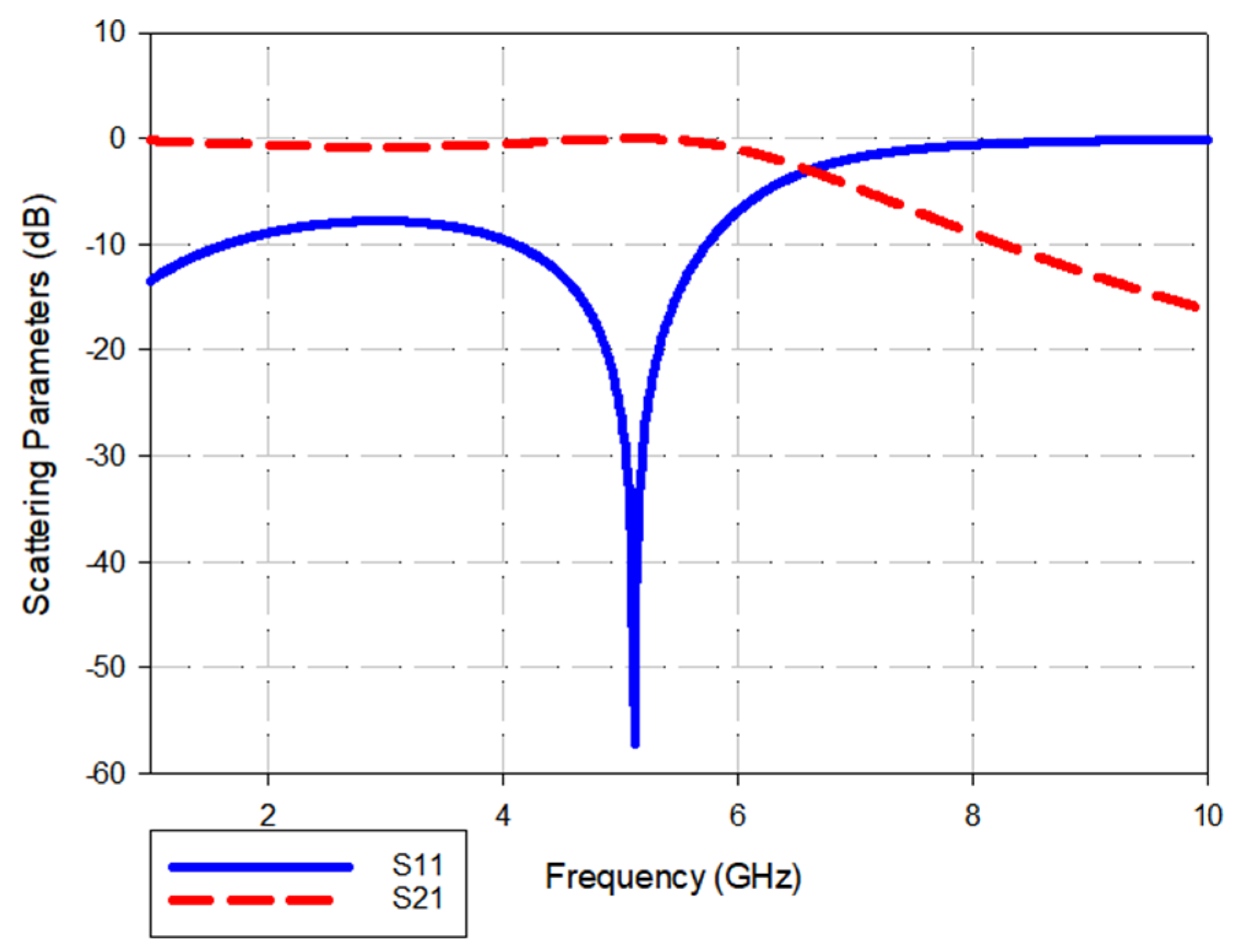
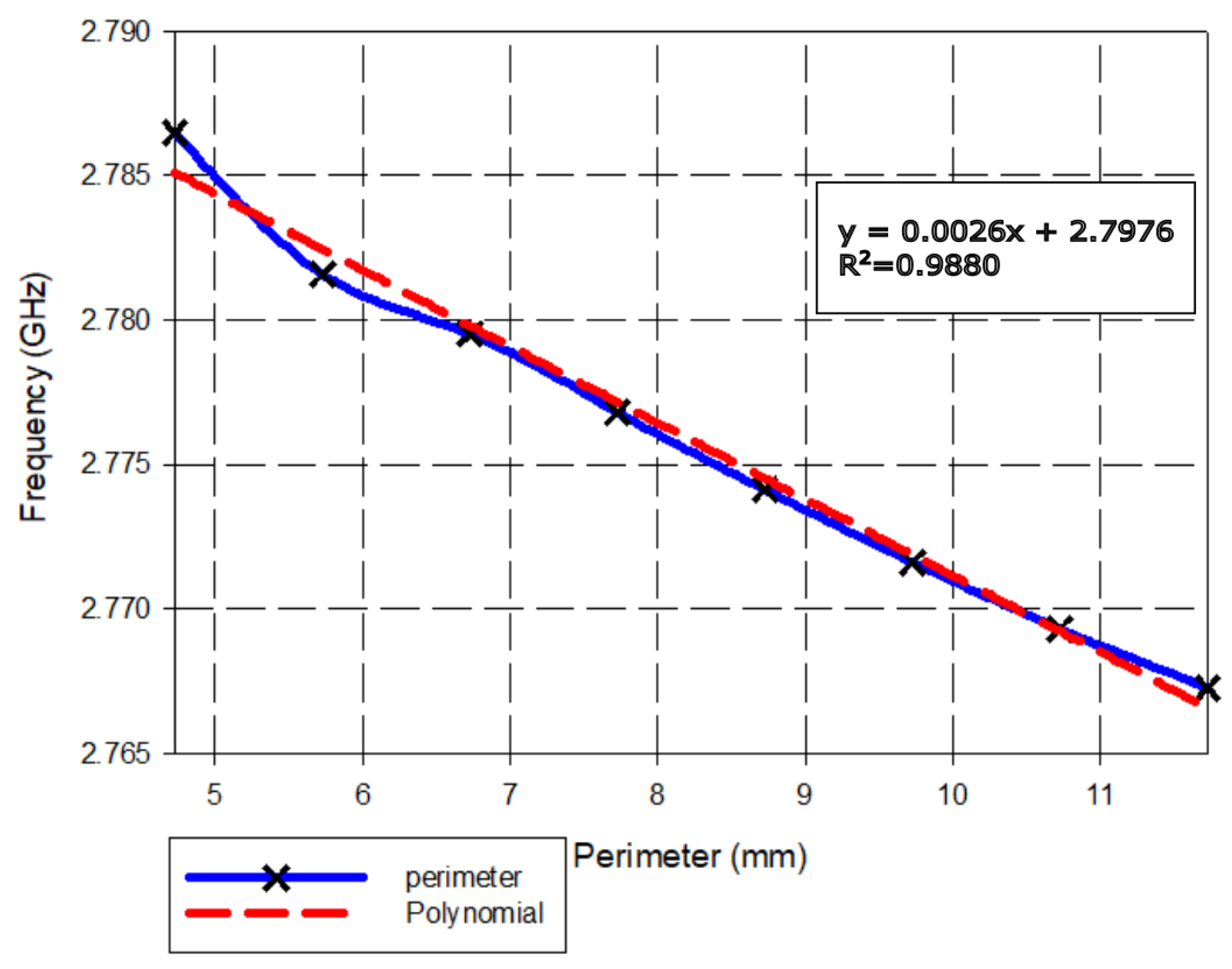
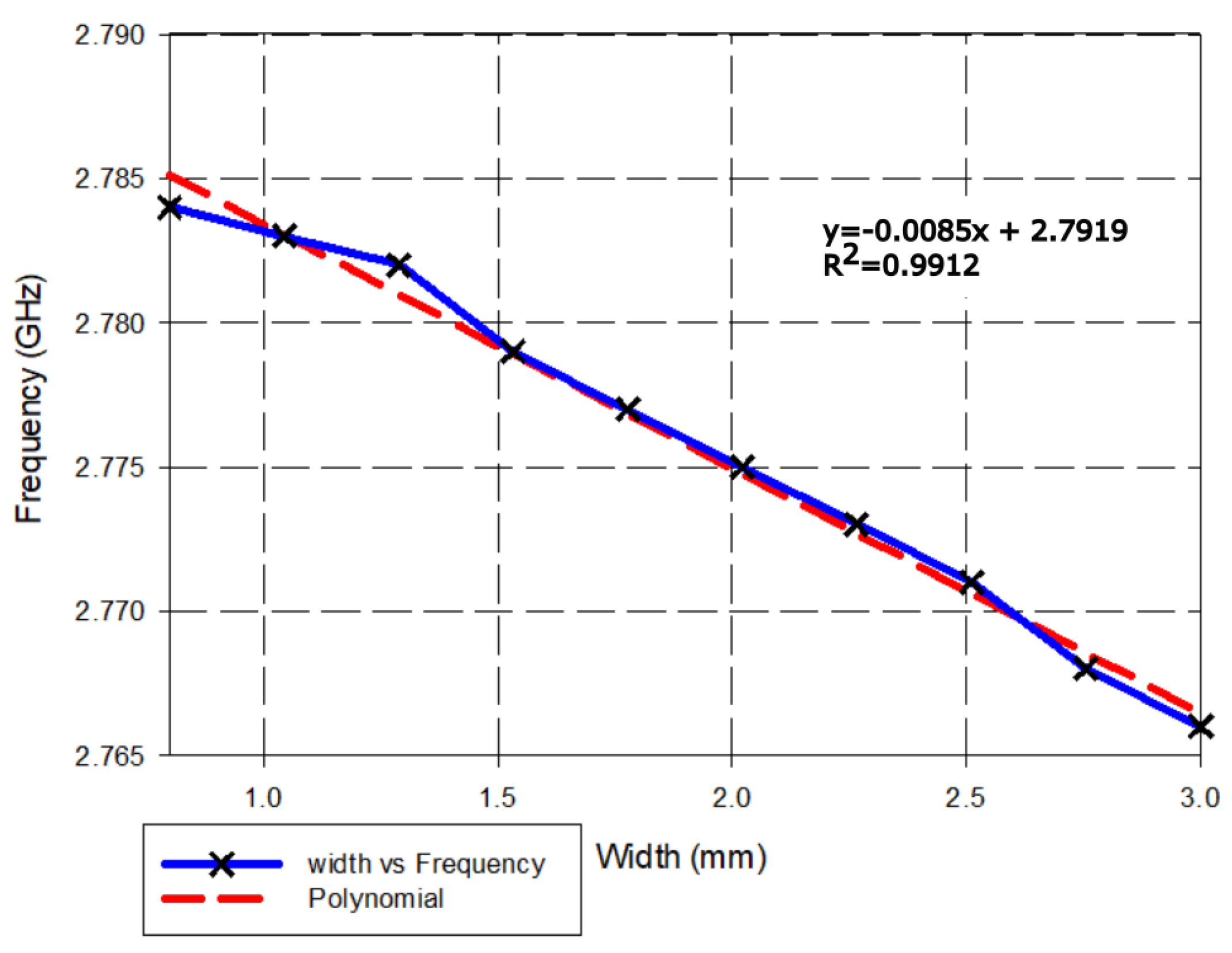
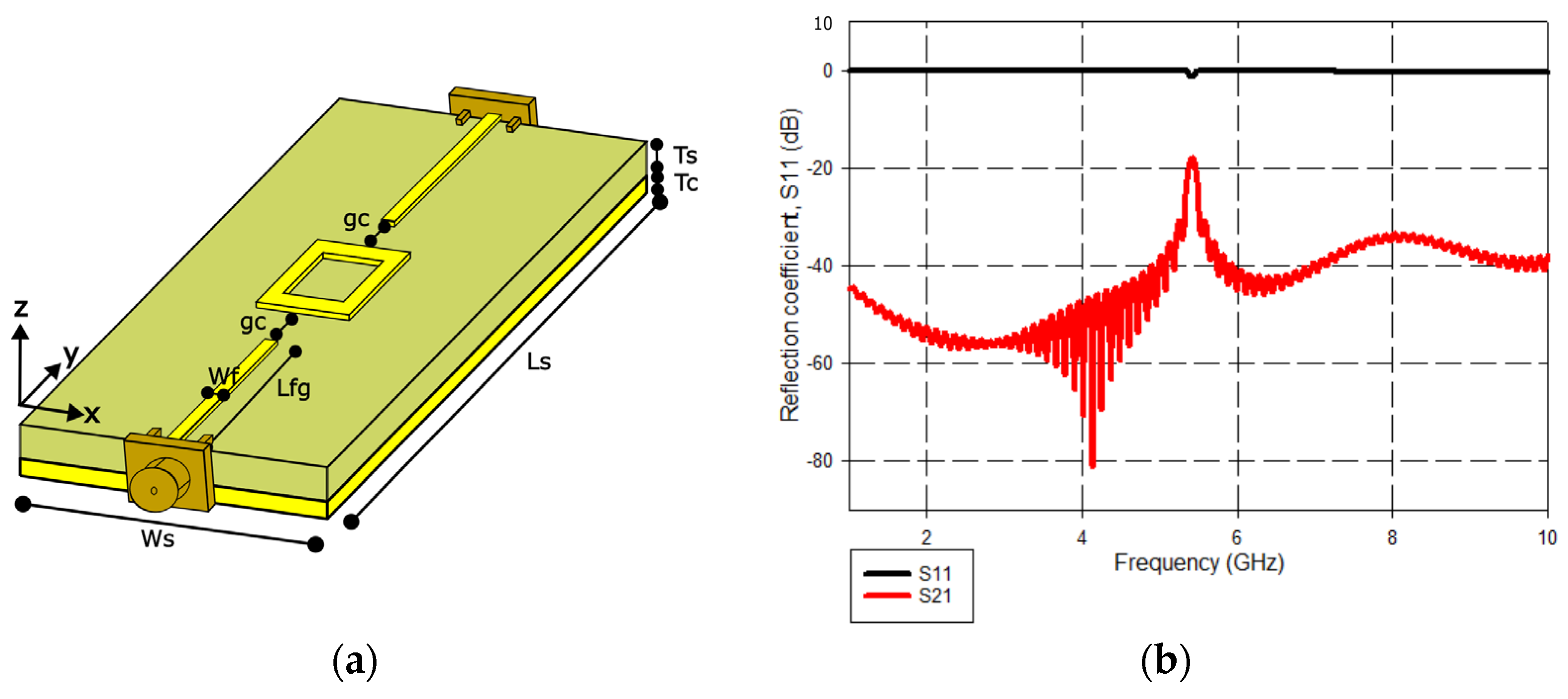
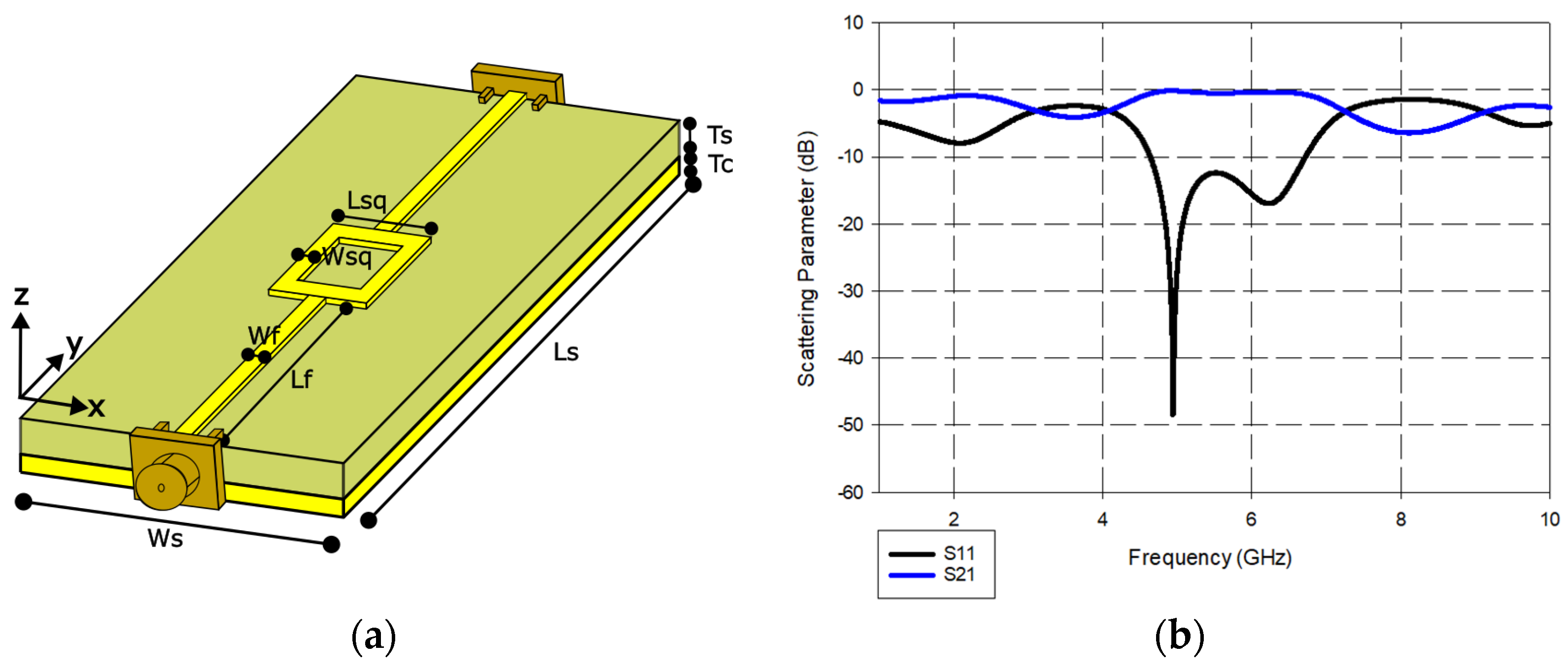
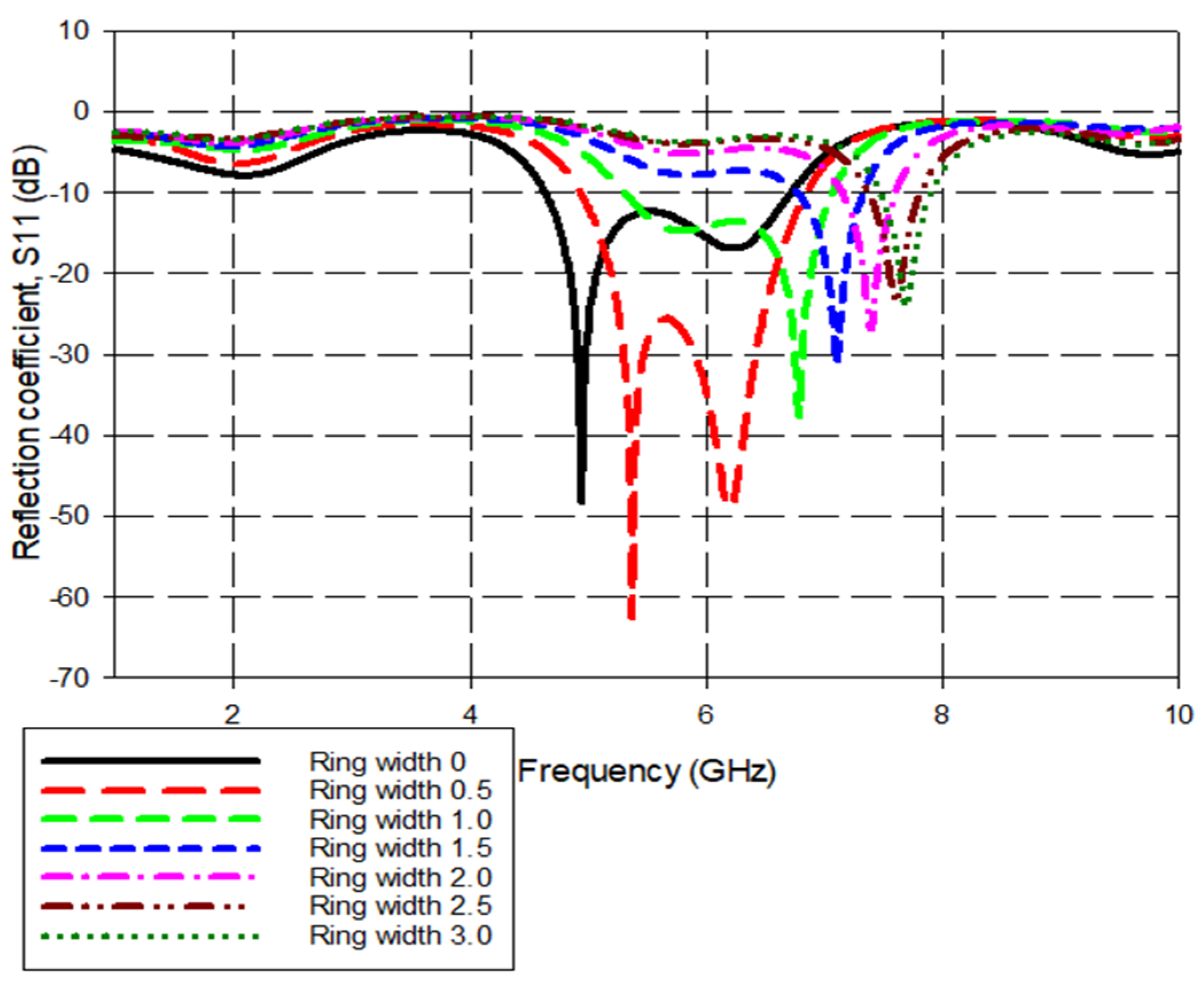
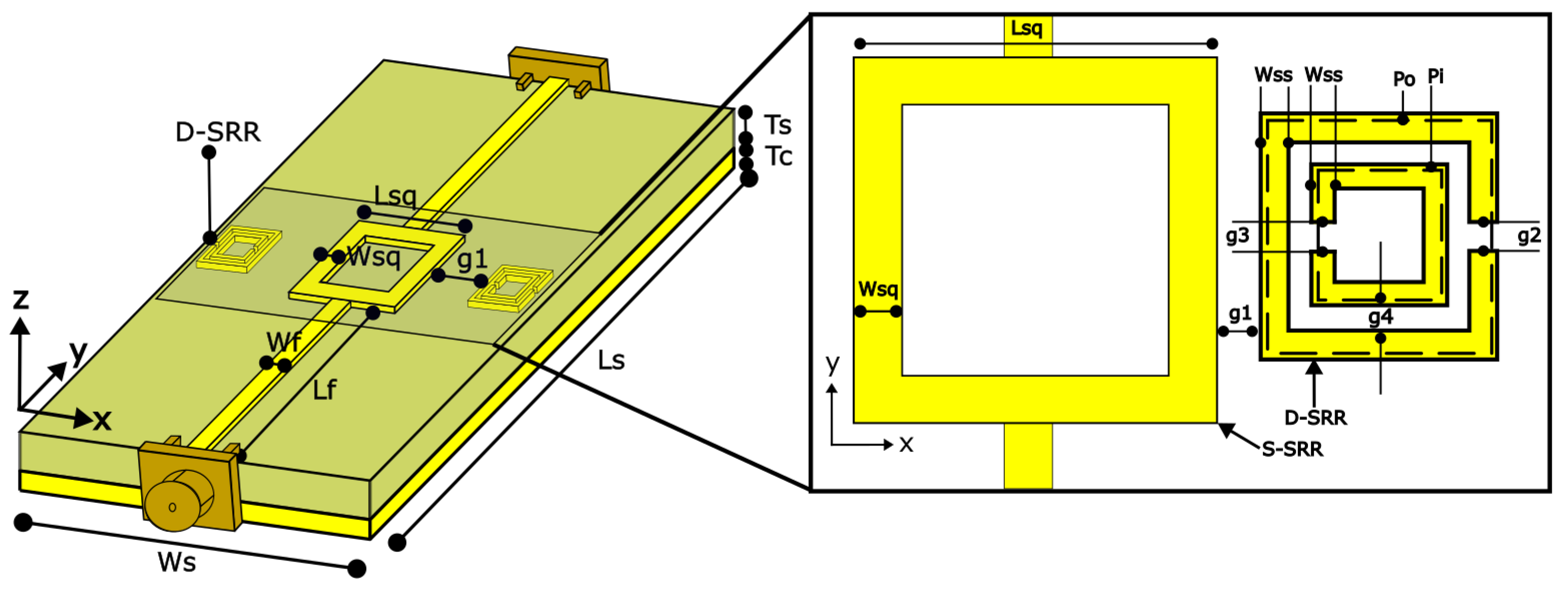
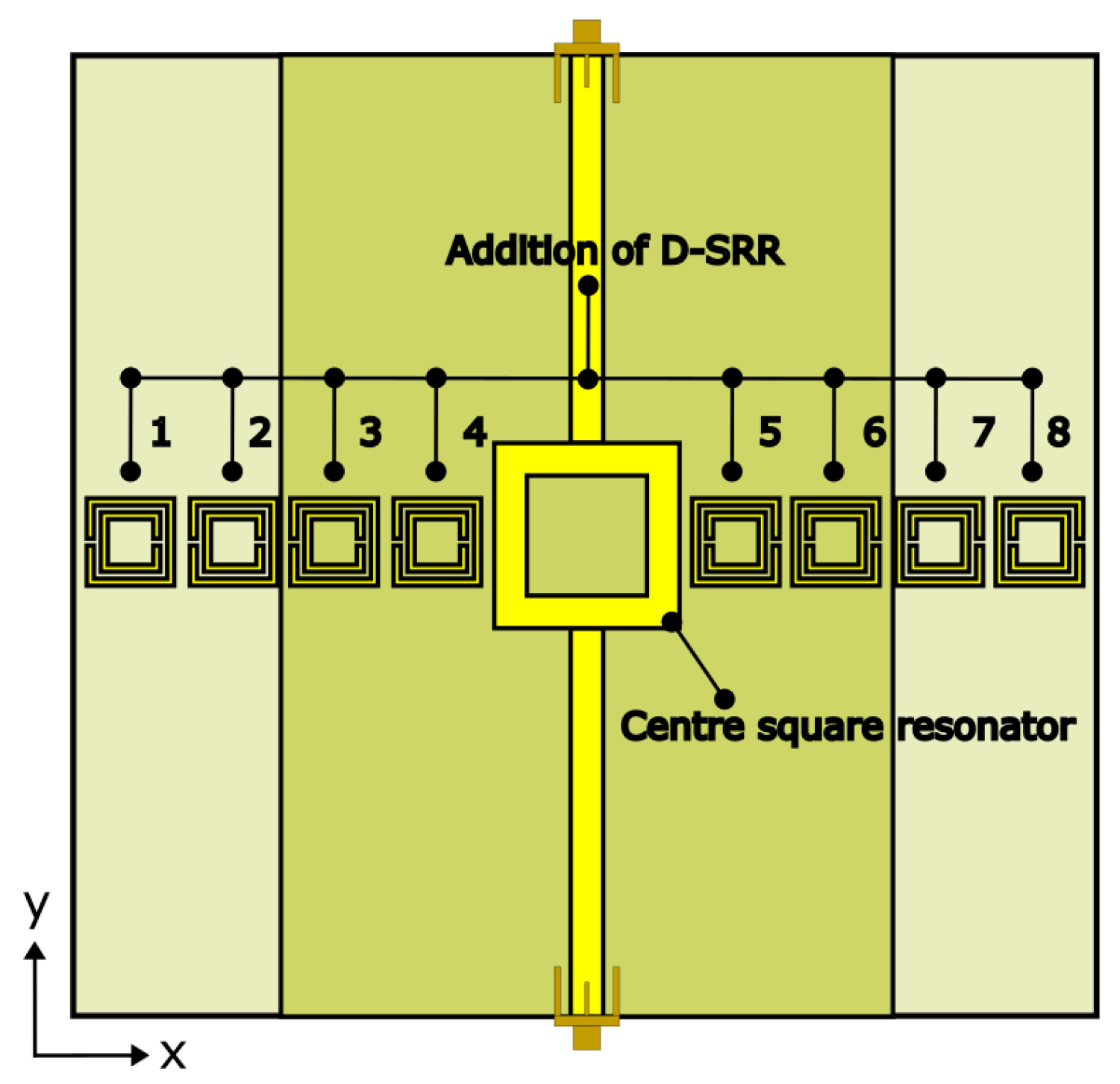


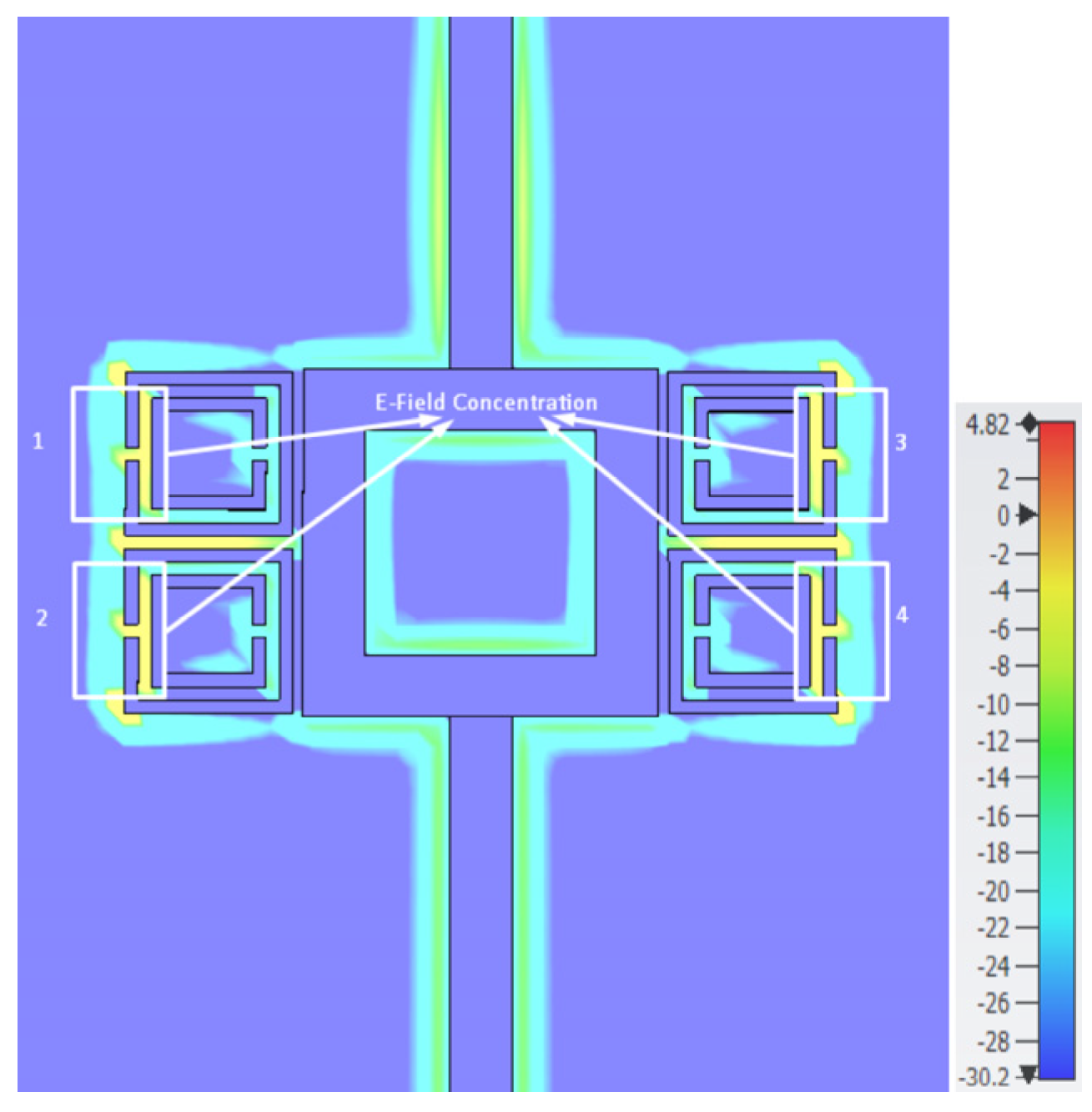
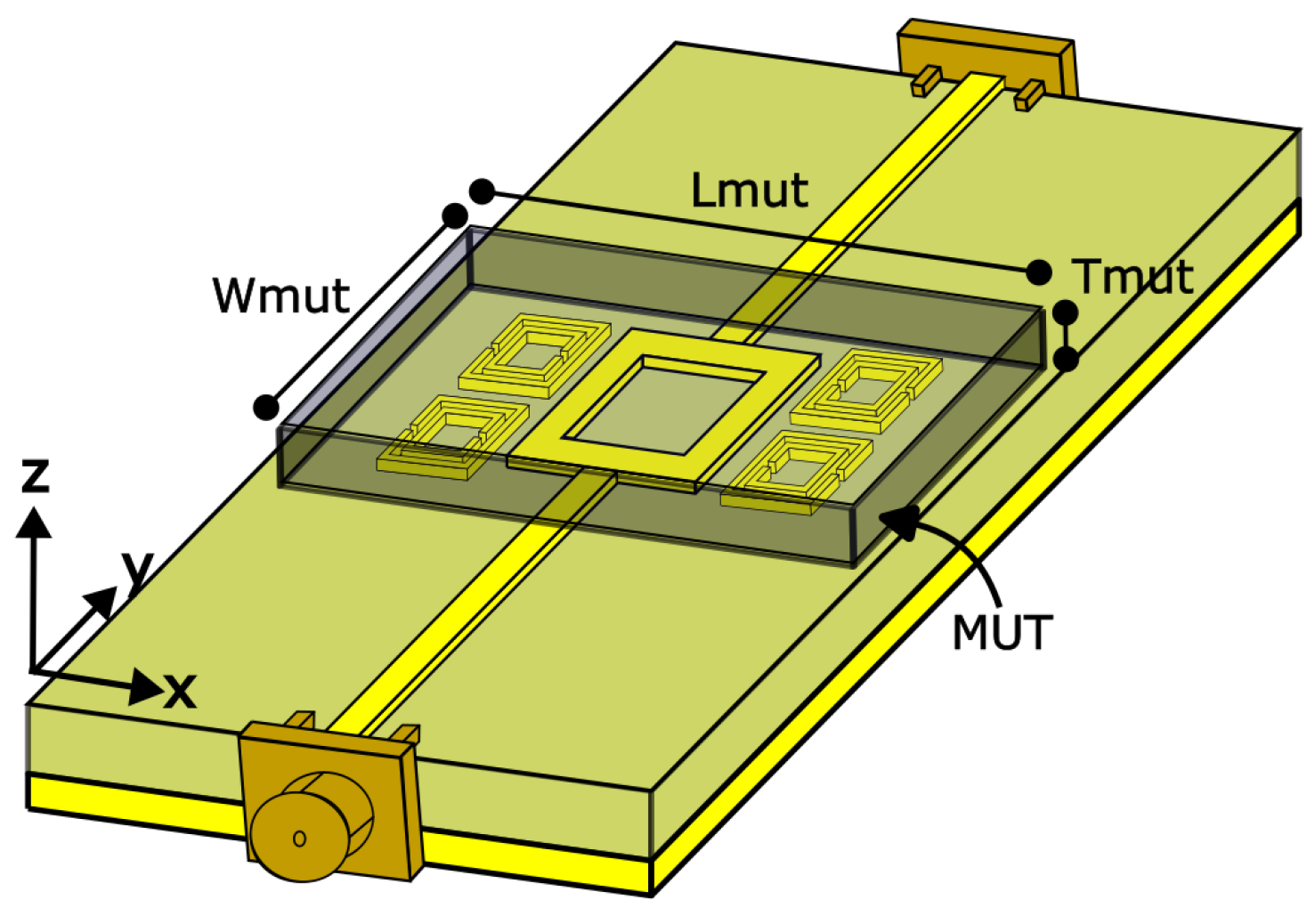

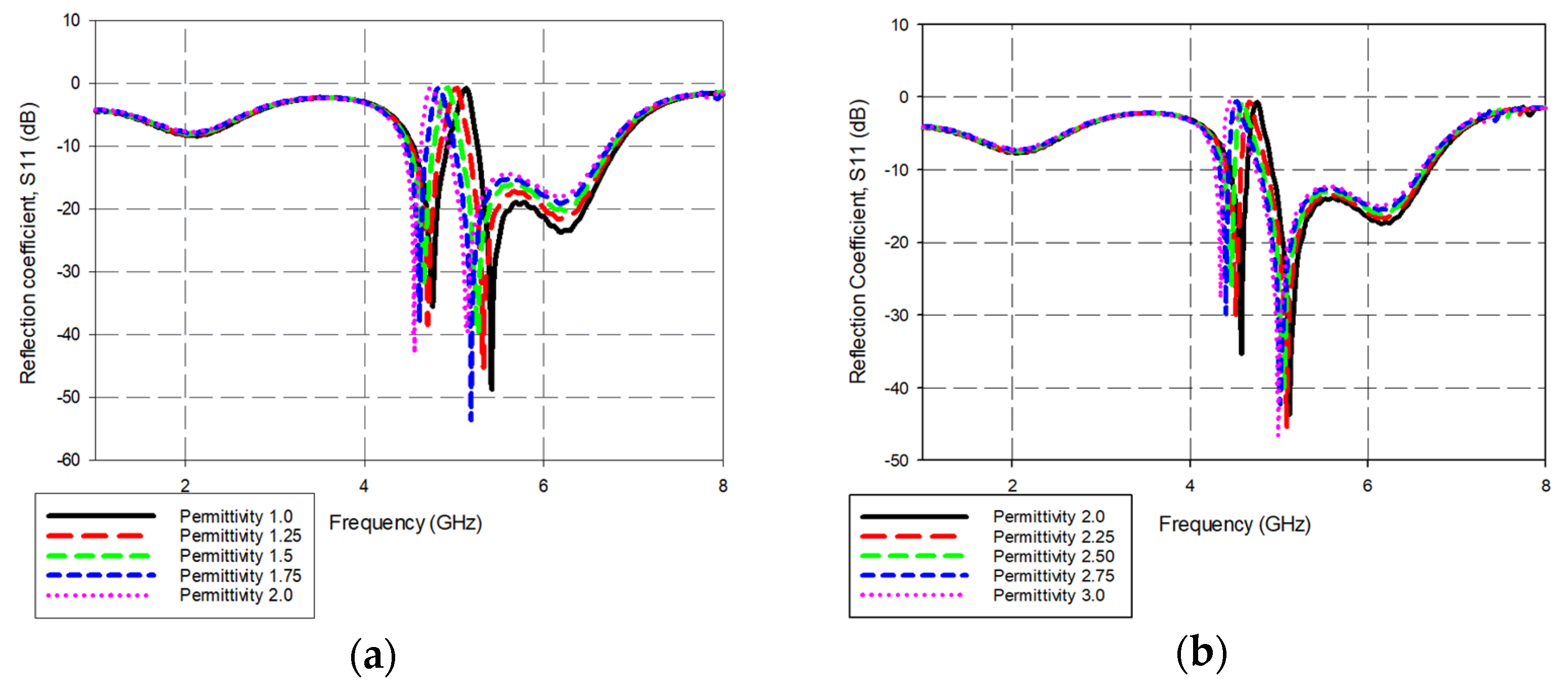

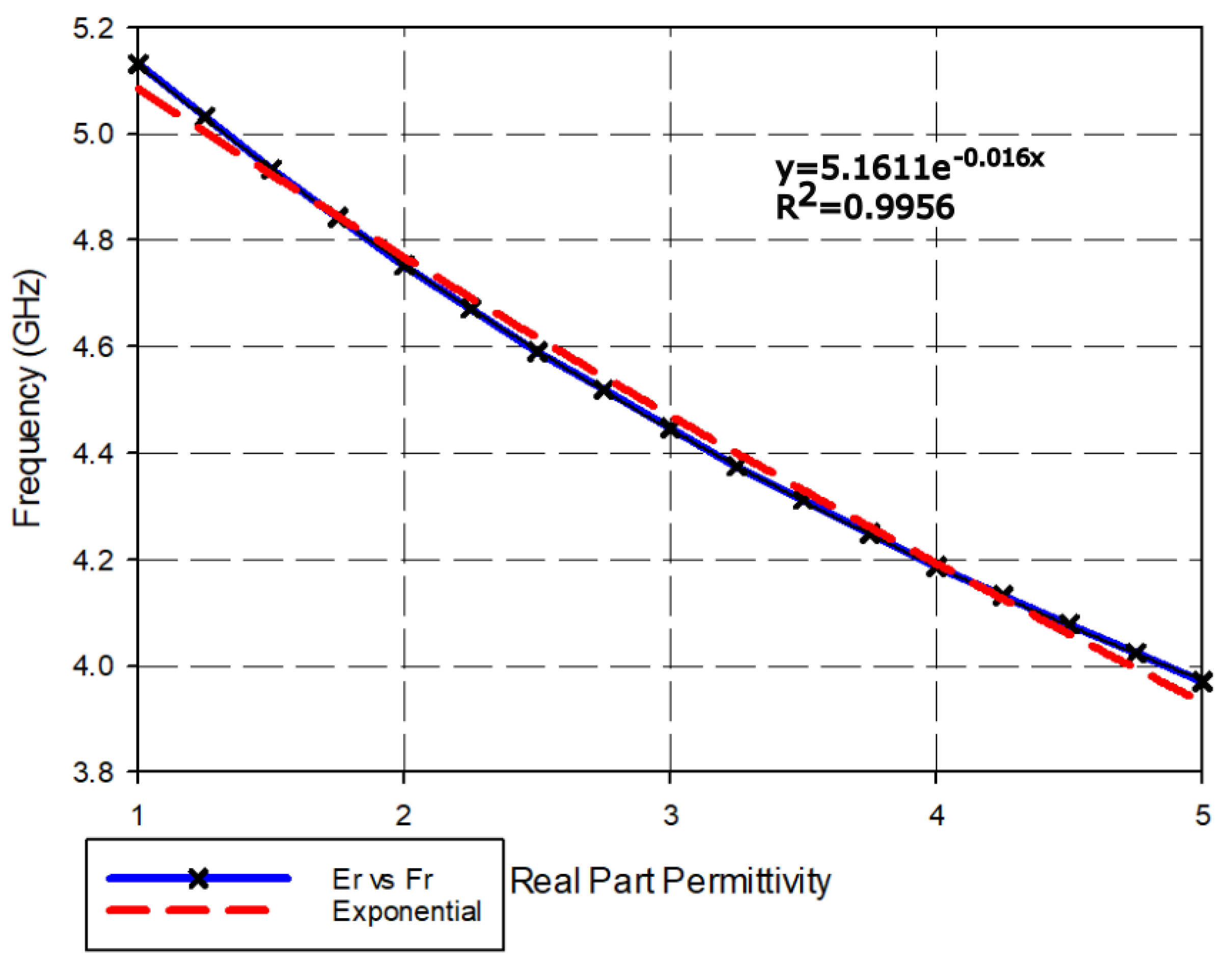

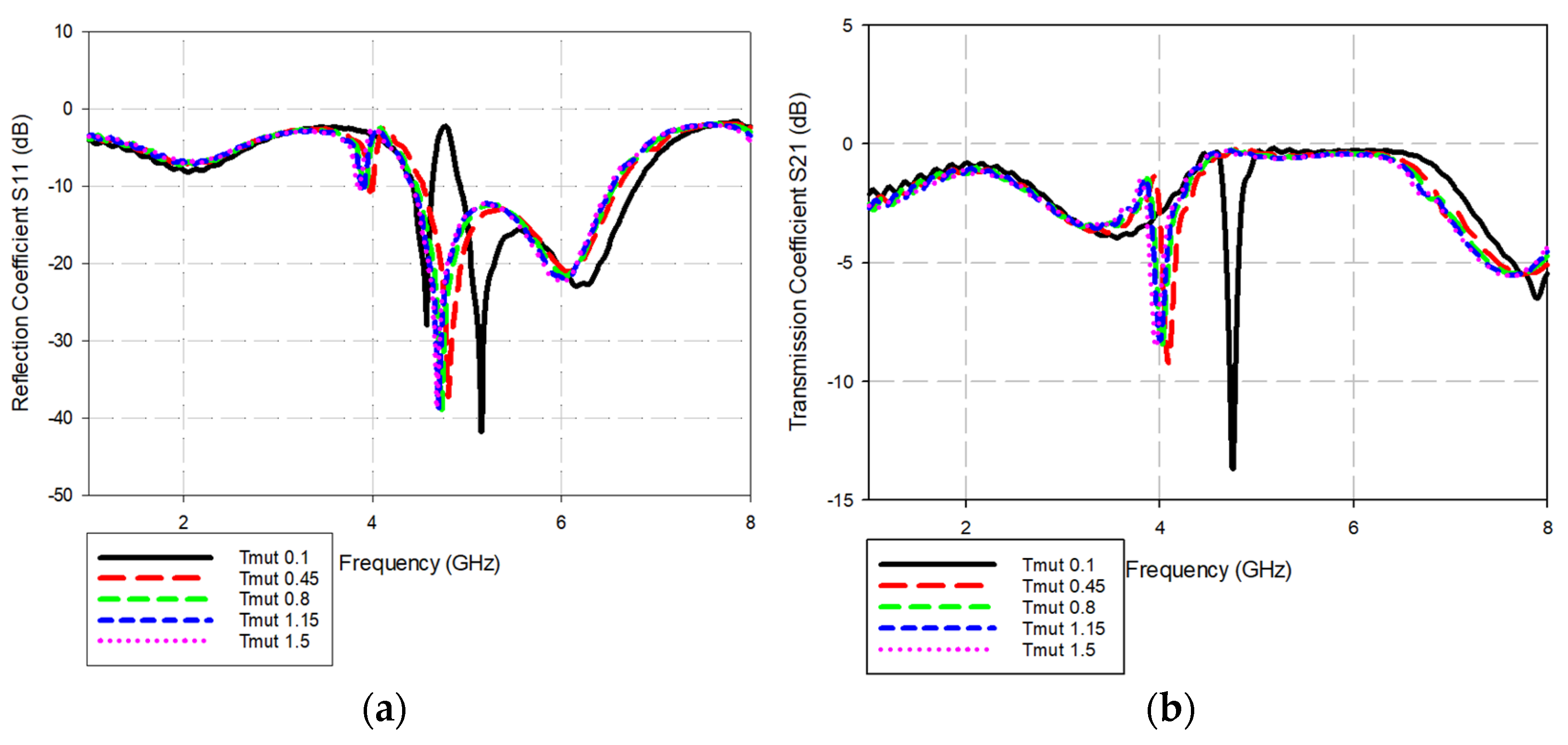
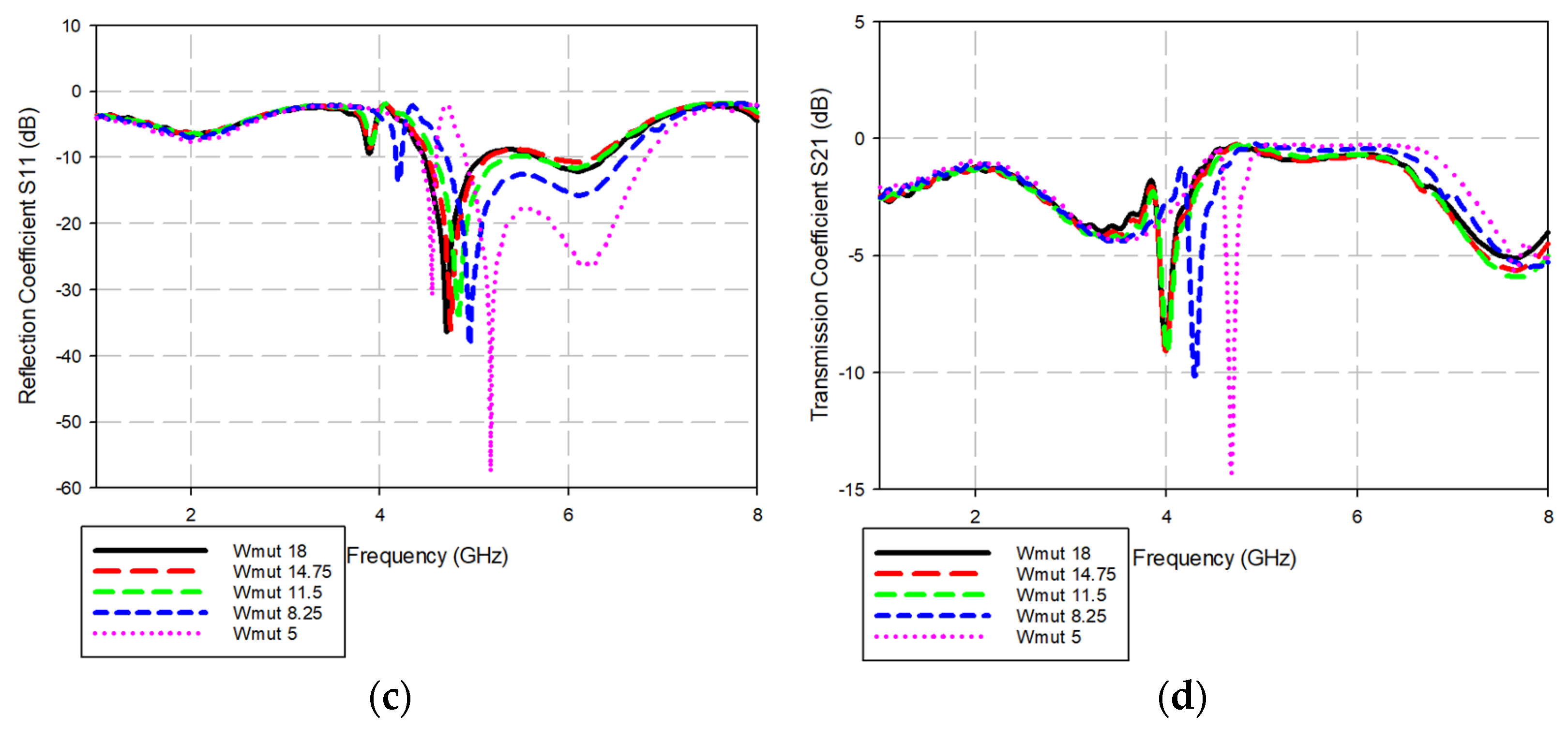
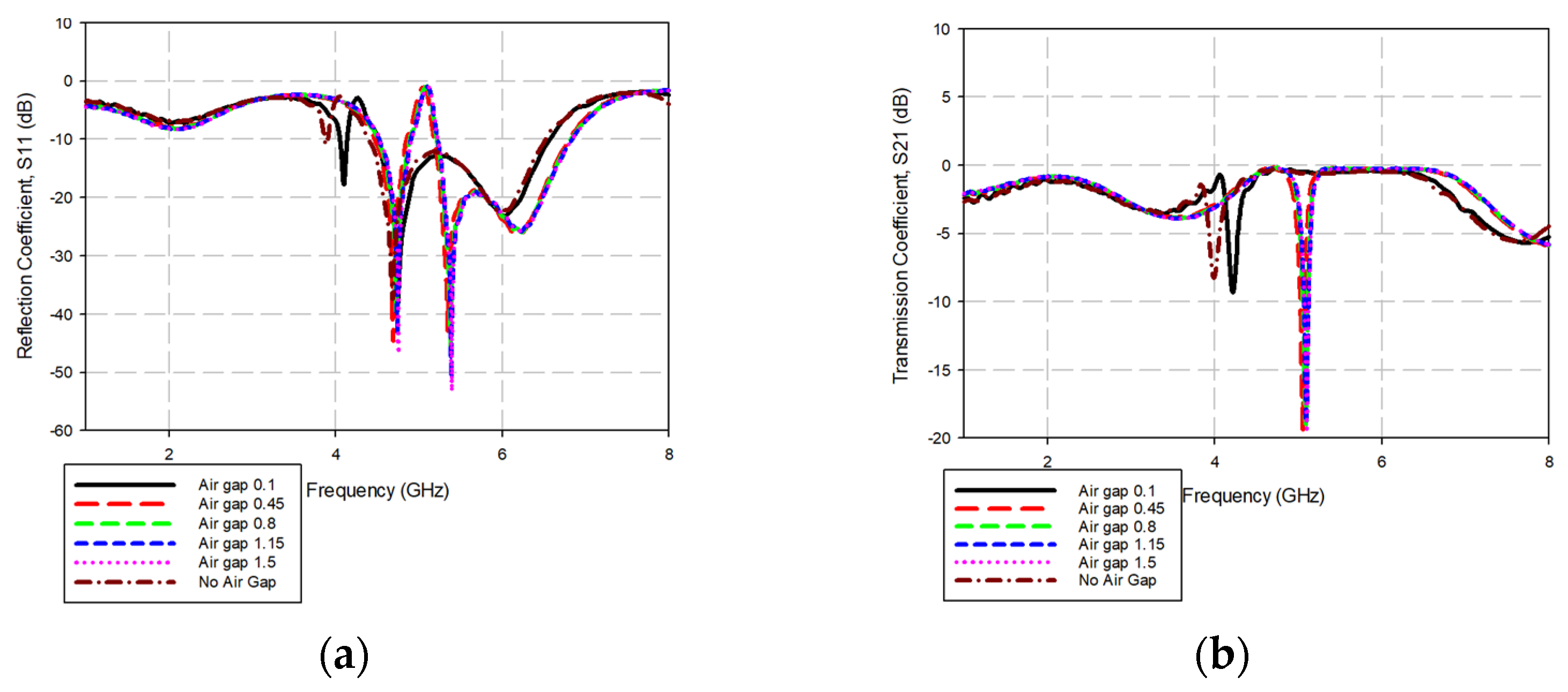
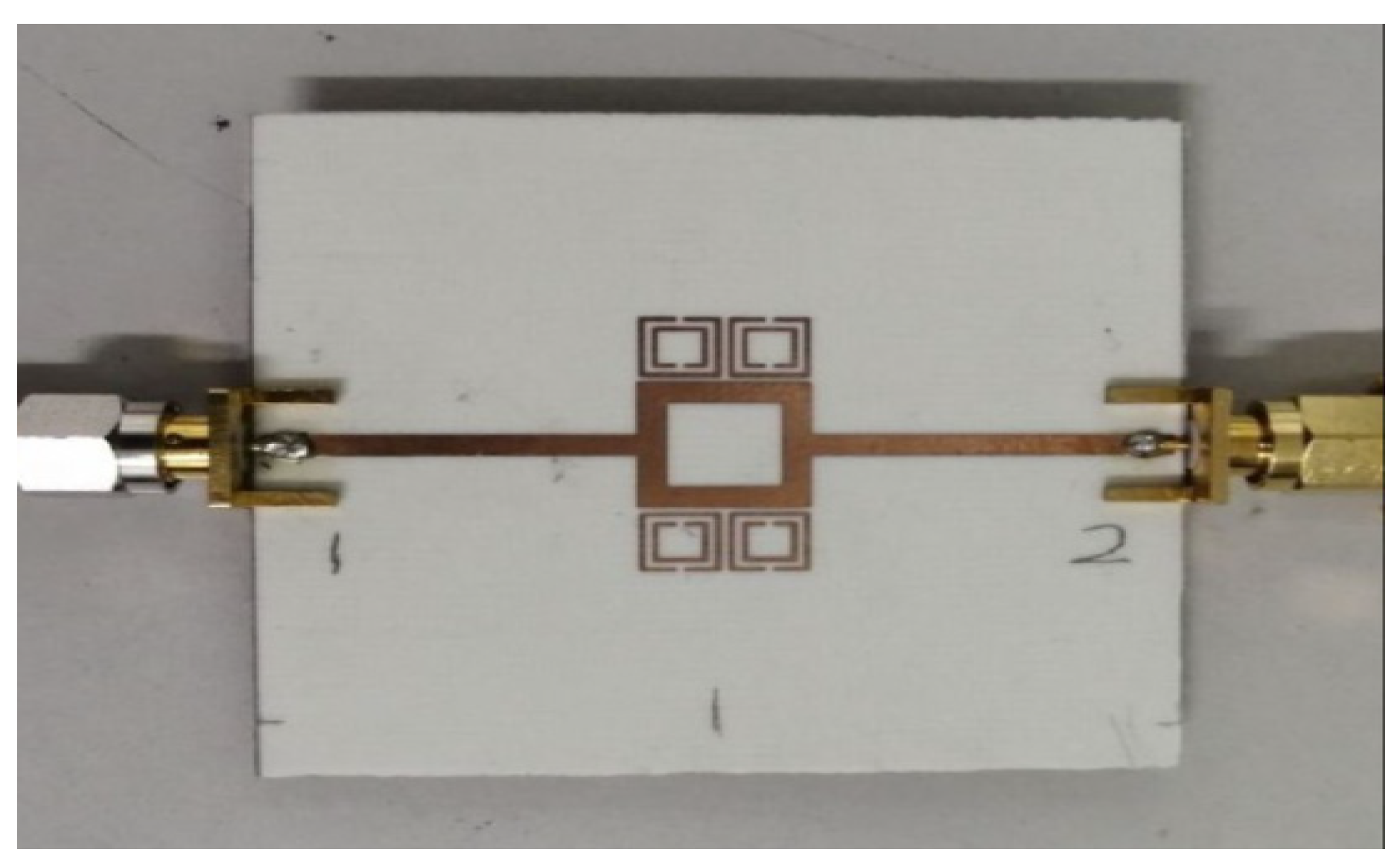
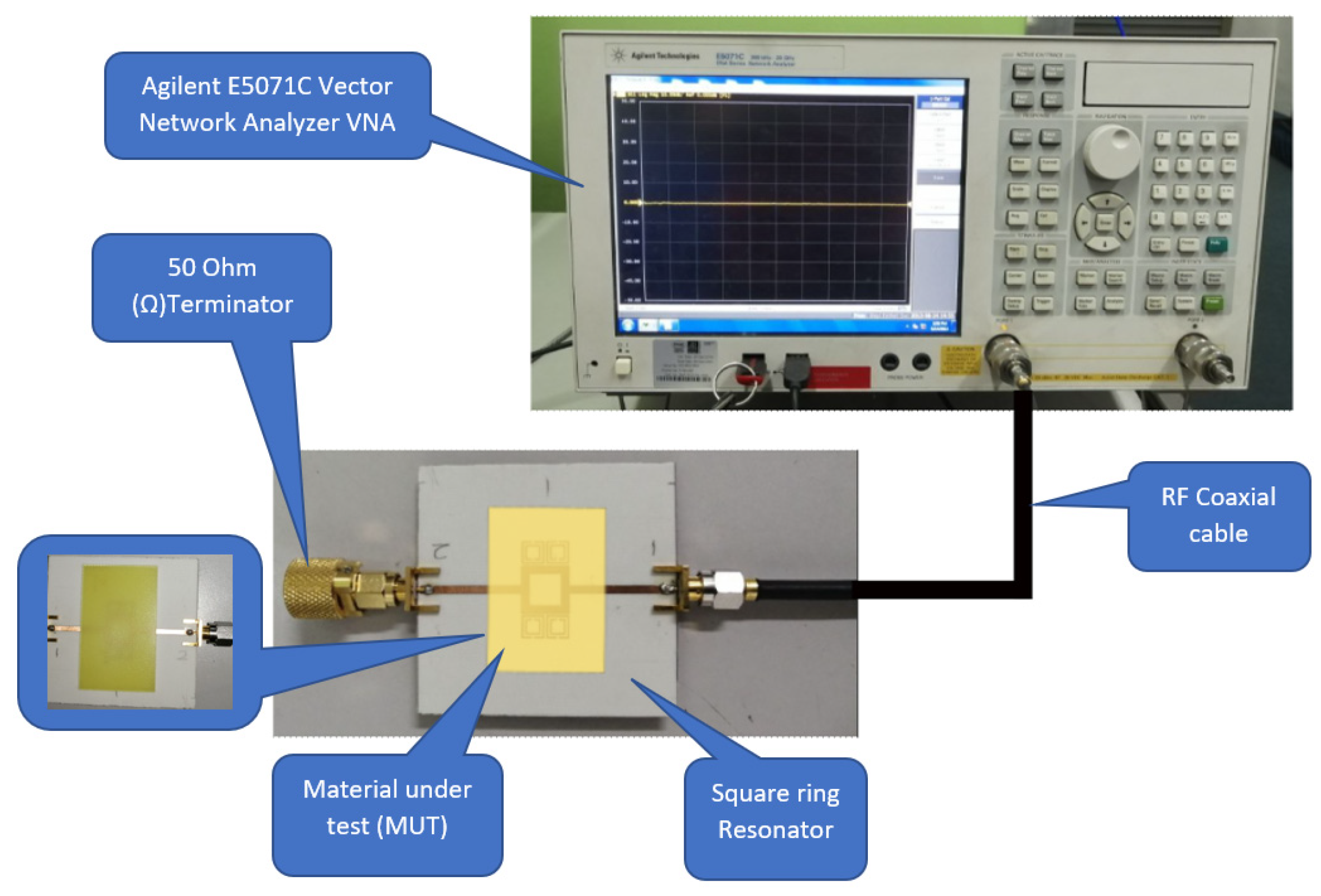
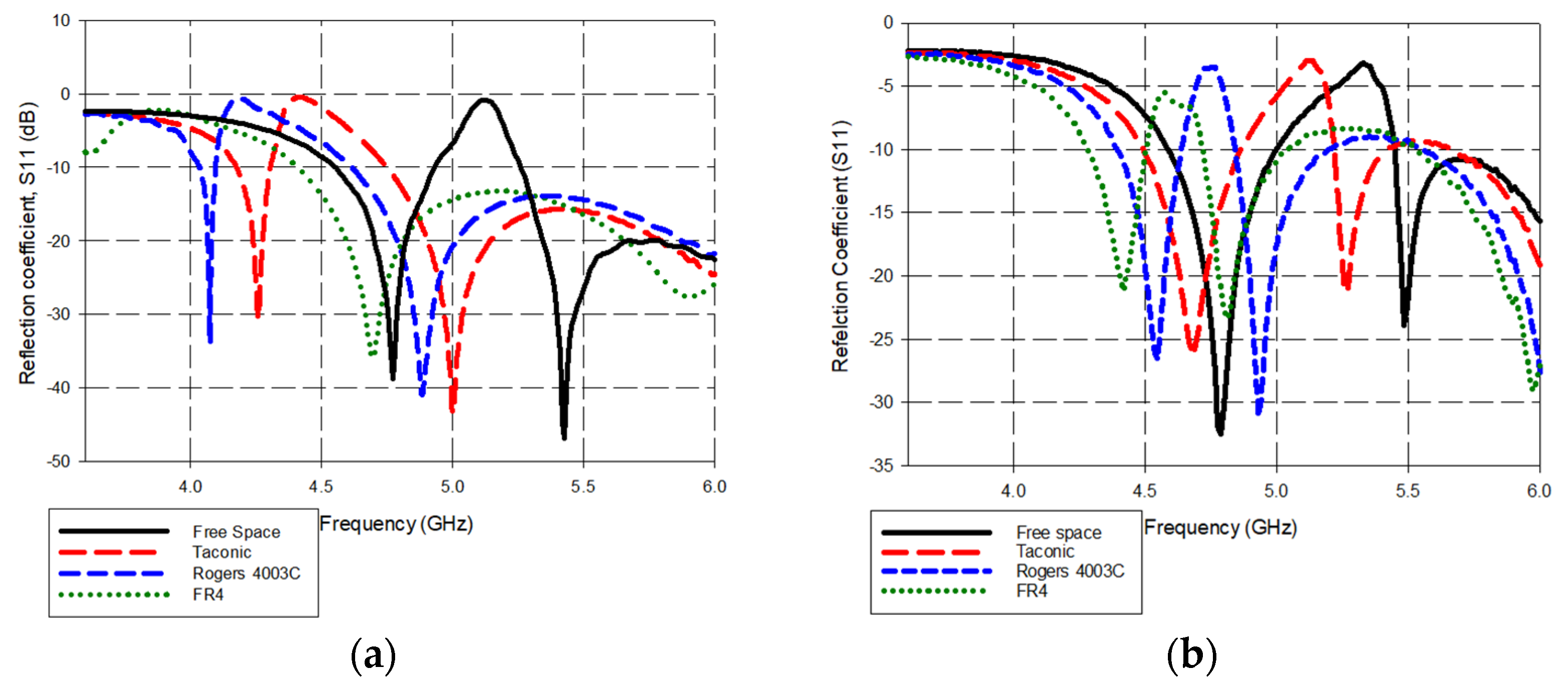

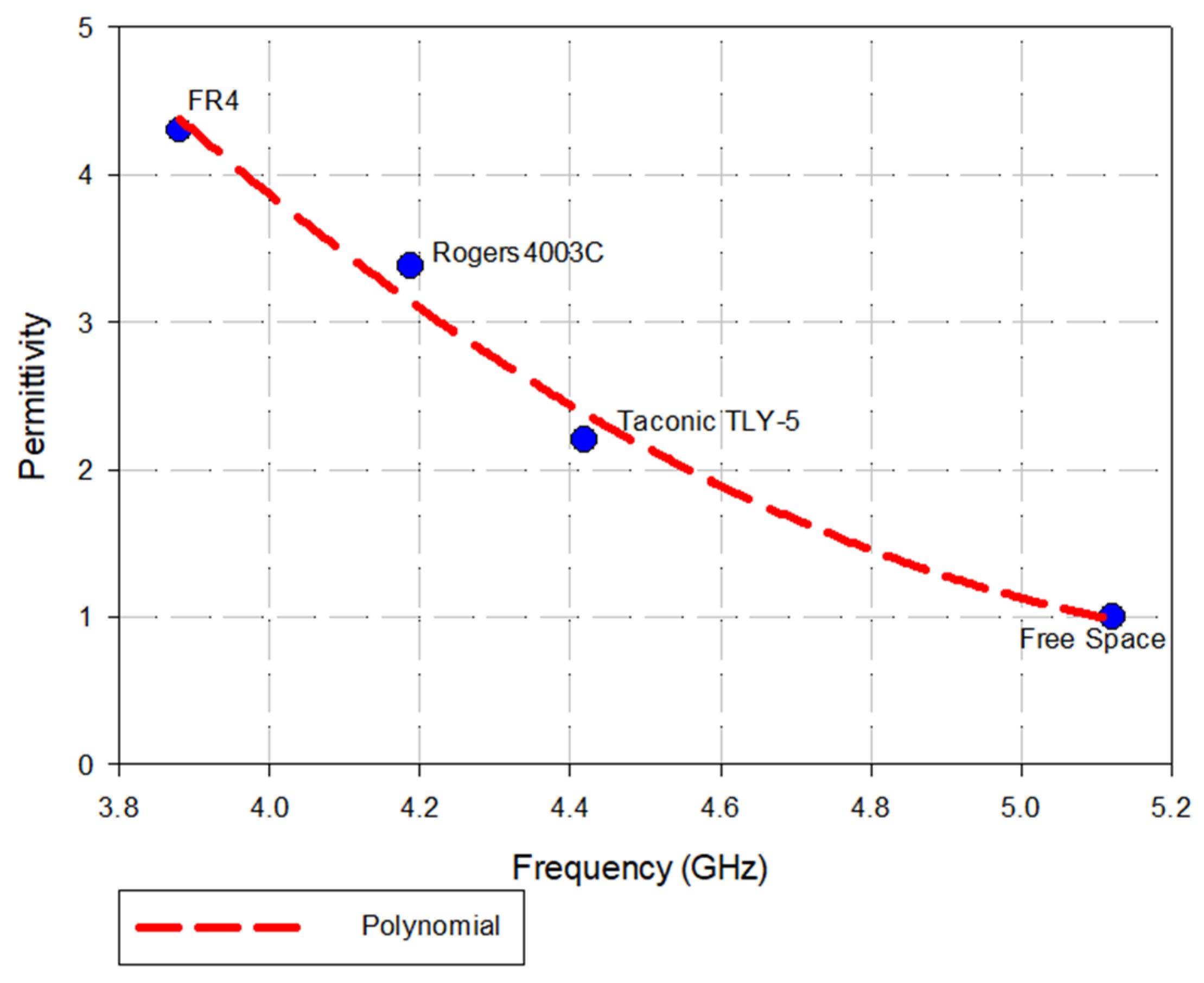
| Parameter | Value |
|---|---|
| Input impedance, Z1 | 50.0 Ω |
| Output impedance, Z2 | 50.0 Ω |
| Capacitor, C1 | 1.0 nH |
| Capacitor, C2 | 1.0 nH |
| Inductor, L | 1.395 pF |
| Resonance frequency, fr | 5.122 GHz |
| Parameters | Value (mm) |
|---|---|
| Width of substrate (Ws) | 35.0 |
| Length of substrate (Ls) | 55.0 |
| Thickness of substrate (Ts) | 0.508 |
| Thickness of copper (Tc) | 0.017 |
| Width of feed line (Wf) | 1.860 |
| Length of feed line (Lf) | 22.21 |
| Length of square resonator (Lsq) | 10.587 |
| Width of square resonator (Wsq) | 1.860 |
| Permittivity (εr) | Resonance Frequency (fr) | f1 | f2 | Δf | Quality Factor (Q) |
|---|---|---|---|---|---|
| 1.00 | 5.1310 | 5.0560 | 5.1929 | 0.1370 | 37.4526 |
| 1.25 | 5.0320 | 4.9545 | 5.0885 | 0.1340 | 37.5522 |
| 1.50 | 4.9330 | 4.8597 | 4.9911 | 0.1314 | 37.5419 |
| 1.750 | 4.8430 | 4.7708 | 4.9000 | 0.1292 | 37.4845 |
| 2.00 | 4.7530 | 4.6873 | 4.8149 | 0.1276 | 37.2492 |
| 2.25 | 4.6720 | 4.6078 | 4.7362 | 0.1284 | 36.3863 |
| 2.50 | 4.5910 | 4.5333 | 4.6657 | 0.1324 | 34.6752 |
| 2.75 | 4.5190 | 4.4618 | 4.6103 | 0.1485 | 30.4310 |
| 3.00 | 4.4470 | 4.3930 | 4.5512 | 0.1581 | 28.1278 |
| 3.25 | 4.3750 | 4.3282 | 4.4904 | 0.1622 | 26.9729 |
| 3.50 | 4.3120 | 4.2651 | 4.4321 | 0.1670 | 25.8204 |
| 3.75 | 4.24899 | 4.2048 | 4.3825 | 0.1777 | 23.9111 |
| 4.00 | 4.1860 | 4.1471 | 4.3593 | 0.2122 | 19.7267 |
| 4.25 | 4.13199 | 4.0912 | 4.3312 | 0.2400 | 17.2167 |
| 4.50 | 4.07800 | 4.0376 | 4.2880 | 0.2504 | 16.2859 |
| 4.75 | 4.02400 | 3.9867 | 4.2602 | 0.2735 | 14.7130 |
| 5.00 | 3.97000 | 3.9363 | 4.2233 | 0.2870 | 13.8327 |
| Board | Thickness (mm) | Dielectric Constant, ε | Loss Tangent, δ | Dimension (mm) |
|---|---|---|---|---|
| Free space (air) | - | 1.0 | 0 | - |
| Taconic TLY-5 | 1.57 | 2.2 | 0.0009 | 32 × 25 |
| FR4 | 1.60 | 4.3 | 0.017 | 32 × 25 |
| Rogers Duroid 4003C | 0.508 | 3.38 | 0.0027 | 25 × 25 |
| Reference Permittivity (εr) | fs (GHz) | fm (GHz) | frcal (GHz) |
|---|---|---|---|
| 1.00 | 5.1220 | 5.3280 | 6.189 |
| 2.20 | 4.4184 | 5.1240 | 5.998 |
| 3.38 | 4.1880 | 4.7280 | 5.651 |
| 4.30 | 3.8808 | 4.5720 | 5.523 |
| Ref. | Model | Permittivity Range, εr | (MUT) | Resonance frequency, fr (GHz) | Q-Factor (3 dB) | Sensitivity, S (%) |
|---|---|---|---|---|---|---|
| [22] | CSRR (Circular) | 4.25–5.37 | Solid | 2.65 | 53.97 | 2.86 |
| [30] | CSRR (Square) | 1.0–2.0 | Solid | 5.41 | 142 | 6.50 |
| [20] | CSRR (Circular) | 1.0–1.19 | Solid | 5.35 and 7.99 | 38.21 | 3.32 |
| [21] | CSRR (Circular) | 2.8–2.68 and 5.00 | Solid | 4.76 | 19.04 | 9 |
| [31] | CSRR (Circular) | 1.83–2.49 | Solid | 2.24 | 1119 | 0.14 |
| This work | SRR (Square) | 1.0–4.3 | Solid | 5.122 | 37.41 | 3.27 |
Disclaimer/Publisher’s Note: The statements, opinions and data contained in all publications are solely those of the individual author(s) and contributor(s) and not of MDPI and/or the editor(s). MDPI and/or the editor(s) disclaim responsibility for any injury to people or property resulting from any ideas, methods, instructions or products referred to in the content. |
© 2023 by the authors. Licensee MDPI, Basel, Switzerland. This article is an open access article distributed under the terms and conditions of the Creative Commons Attribution (CC BY) license (https://creativecommons.org/licenses/by/4.0/).
Share and Cite
Masrakin, K.; Ibrahim, S.Z.; Rahim, H.A.; Azemi, S.N.; Soh, P.J.; Tantiviwat, S. Microstrip Sensor Based on Ring Resonator Coupled with Double Square Split Ring Resonator for Solid Material Permittivity Characterization. Micromachines 2023, 14, 790. https://doi.org/10.3390/mi14040790
Masrakin K, Ibrahim SZ, Rahim HA, Azemi SN, Soh PJ, Tantiviwat S. Microstrip Sensor Based on Ring Resonator Coupled with Double Square Split Ring Resonator for Solid Material Permittivity Characterization. Micromachines. 2023; 14(4):790. https://doi.org/10.3390/mi14040790
Chicago/Turabian StyleMasrakin, Khuzairi, Siti Zuraidah Ibrahim, Hasliza A. Rahim, Saidatul Norlyana Azemi, Ping Jack Soh, and Sugchai Tantiviwat. 2023. "Microstrip Sensor Based on Ring Resonator Coupled with Double Square Split Ring Resonator for Solid Material Permittivity Characterization" Micromachines 14, no. 4: 790. https://doi.org/10.3390/mi14040790






